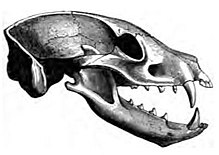
Back حاشر (حيوان) Arabic Insectívoru AST Amprevanetaer Breton Insectivorisme Catalan Hmyzožravost Czech Εντομοφάγο Greek Insektomanĝulo Esperanto Insectívoro Spanish Intsektujale Basque حشرهخواری Persian



An insectivore is a carnivorous animal or plant that eats insects.[1] An alternative term is entomophage,[2] which can also refer to the human practice of eating insects.
The first vertebrate insectivores were amphibians. When they evolved 400 million years ago, the first amphibians were piscivores, with numerous sharp conical teeth, much like a modern crocodile. The same tooth arrangement is however also suited for eating animals with exoskeletons, thus the ability to eat insects is an extension of piscivory.[3]
At one time, insectivorous mammals were scientifically classified in an order called Insectivora. This order is now abandoned, as not all insectivorous mammals are closely related. Most of the Insectivora taxa have been reclassified; those that have not yet been reclassified and found to be truly related to each other remain in the order Eulipotyphla.
Although individually small, insects exist in enormous numbers. Insects make up a very large part of the animal biomass in almost all non-marine, non-polar environments. It has been estimated that the global insect biomass is in the region of 1012 kg (one billion tons) with an estimated population of 1018 (one billion billion, or quintillion) organisms.[4]: 13 Many creatures depend on insects as their primary diet, and many that do not (and are thus not technically insectivores) nevertheless use insects as a protein supplement, particularly when they are breeding.[5]
- ^ Miller, George A. (2009). "Article for insectivorous". WordNet. Princeton University. Retrieved 1 April 2010.
- ^ Gullan, P.J.; Cranston, P.S. (2005). The Insects: An outline of entomology. Malden, MA: Blackwell Publishing. p. 455. ISBN 978-1-4051-1113-3.
- ^ Sahney, S.; Benton, M.J.; Falcon-Lang, H.J. (2010). "Rainforest collapse triggered Pennsylvanian tetrapod diversification in Euramerica" (PDF). Geology. 38 (12): 1079–1082. Bibcode:2010Geo....38.1079S. doi:10.1130/G31182.1.
- ^ Dudley, Robert (2002). "Flight and the Pterygote Insecta". The Biomechanics of Insect Flight: Form, function, evolution. Princeton University Press. pp. 3–35. ISBN 978-0-691-09491-5.
- ^ Whitney, Stephen R.; Sandelin, R. (2004). Field Guide to the Cascades & Olympics. The Mountaineers Books. p. 317. ISBN 978-0-89886-808-1. Retrieved 1 April 2010.